Tutorial
Physical Layer
Data Link layer
Network Layer
Routing Algorithm
Transport Layer
Application Layer
Network Security
Misc
- Router
- OSI vs TCP/IP
- TCP vs UDP
- Transmission Control Protocol
- TCP port
- IPv4 vs IPv6
- ARP Packet Format
- ARP Table
- Working of ARP
- FTP Client
- FTP Commands
- FTP Server
- I2C Protocol
- Sliding Window Protocol
- SPI Protocol
- IP
- ARP Commands
- ARP
- Address Resolution Protocol
- ARP and its types
- TCP Retransmission
- CAN protocol
- HTTP Status Codes
- HTTP vs HTTPS
- RIP Protocol
- UDP Protocol
- ICMP Protocol
- MQTT protocol
- OSPF Protocol
- Stop and Wait Protocol
- IMAP Protocol
- POP Protocol
- CIFS
- DAS
- DIMM
- iSCSI
- NAS (Network Attached Storage)
- NFS
- NVMe
- SAN
- Border Gateway Protocol
- Go-Back-N ARQ
- RJ Cable
- Difference between Connection-Oriented and Connectionless Service
- CDMA vs. GSM
- What is MAC Address
- Modem vs. Router
- Switch Vs. Router
- USB 2.0 vs 3.0
- Difference between CSMA CA and CSMA CD
- Multiple access protocol- ALOHA, CSMA, CSMA/CA and CSMA/CD
- URI vs URL
- IMAP vs. POP3
- SSH Meaning| SSH Protocol
- UTP vs STP
- Status Code 400
- MIME Protocol
- IP address
- proxy server
- How to set up and use a proxy server
- network security
- WWW is based on which model
- Proxy Server List
- Fundamentals of Computer Networking
- IP Address Format and Table
- Bus topology and Ring topology
- Bus topology and Star topology
- Circuit Switching and Packet switching?
- Difference between star and ring topology
- Difference between Router and Bridge
- TCP Connection Termination
- Image Steganography
- Network Neutrality
- Onion Routing
- Adaptive security appliance (ASA) features
- Relabel-to-front Algorithm
- Types of Server Virtualization in Computer Network
- Access Lists (ACL)
- What is a proxy server and how does it work
- Digital Subscriber Line (DSL)
- Operating system based Virtualization
- Context based Access Control (CBAC)
- Cristian's Algorithm
- Service Set Identifier (SSID)
- Voice over Internet Protocol (VoIP)
- Challenge Response Authentication Mechanism (CRAM)
- Extended Access List
- Li-fi vs. Wi-fi
- Reflexive Access List
- Synchronous Optical Network (SONET)
- Wifi protected access (WPA)
- Wifi Protected Setup (WPS)
- Standard Access List
- Time Access List
- What is 3D Internet
- 4G Mobile Communication Technology
- Types of Wireless Transmission Media
- Best Computer Networking Courses
- Data Representation
- Network Criteria
- Classful vs Classless addressing
- Difference between BOOTP and RARP in Computer Networking
- What is AGP (Accelerated Graphics Port)
- Advantages and Disadvantages of Satellite Communication
- External IP Address
- Asynchronous Transfer Mode (ATM)
- Types of Authentication Protocols
- What is a CISCO Packet Tracer
- BOOTP work
- Subnetting in Computer Networks
- Mesh Topology Advantages and Disadvantages
- Ring Topology Advantages and Disadvantages
- Star Topology Advantages and Disadvantages
- Tree Topology Advantages and Disadvantages
- Zigbee Technology-The smart home protocol
- Network Layer in OSI Model
- Physical Layer in OSI Model
- Data Link Layer in OSI Model
- Internet explorer shortcut keys
- Network Layer Security | SSL Protocols
- Presentation Layer in OSI Model
- Session Layer in OSI Model
- SUBNET MASK
- Transport Layer Security | Secure Socket Layer (SSL) and SSL Architecture
- Functions, Advantages and Disadvantages of Network Layer
- Protocols in Noiseless and Noisy Channel
- Advantages and Disadvantages of Mesh Topology
- Cloud Networking - Managing and Optimizing Cloud-Based Networks
- Collision Domain and Broadcast Domain
- Count to Infinity Problem in Distance Vector Routing
- Difference Between Go-Back-N and Selective Repeat Protocol
- Difference between Stop and Wait, GoBackN, and Selective Repeat
- Network Function Virtualization (NFV): transforming Network Architecture with Virtualized Functions
- Network-Layer Security | IPSec Modes
- Next - Prev Network-Layer Security | IPSec Protocols and Services
- Ping vs Traceroute
- Software Defined Networking (SDN): Benefits and Challenges of Network Virtualization
- Software Defined Networking (SDN) vs. Network Function Virtualization (NFV)
- Virtual Circuits vs Datagram Networks
- BlueSmack Attack in Wireless Networks
- Bluesnarfing Attack in Wireless Networks
- Direct Sequence Spread Spectrum
- Warchalking in Wireless Networks
- WEP (Wired Equivalent Privacy)
- Wireless security encryption
- Wireless Security in an Enterprise
- Quantum Networking
- Network Automation
- Difference between MSS and MTU
- What is MTU
- Mesh Networks: A decentralized and Self-Organizing Approach to Networking
- What is Autonomous System
- What is MSS
- Cyber security & Software security
- Information security & Network security.
- Security Engineer & Security Architect
- Protection Methods for Network Security
- Trusted Systems in Network Security
- What are Authentication Tokens in Network security
- Cookies in Network Security
- Intruders in Network Security
- Network Security Toolkit (NST) in virtual box
- Pivoting-Moving Inside a Network
- Security Environment in Computer Networks
- Voice Biometric technique in Network Security
- Advantages and Disadvantages of Conventional Testing
- Difference between Kerberos and LDAP
- Cyber security and Information Security
- GraphQL Attacks and Security
- Application Layer in OSI Model
- Applications of Remote Sensing
- Seven Layers of IT Security
- What is Ad Hoc TCP
- What is Server Name Indication(SNI)
Border Gateway Protocol
It is an interdomain routing protocol, and it uses the path-vector routing. It is a gateway protocol that is used to exchange routing information among the autonomous system on the internet.
As we know that Border Gateway Protocol works on different autonomous systems, so we should know the history of BGP, types of autonomous systems, etc.
History of BGP
The first network was ARPANET, which the department of defense developed, and the Advanced Research Project Agency designed it. In Arpanet, only one network exists, which was handled by the single administrator. All the routers were the part of the single network, and the routing was performed with the help of the GGP (Gateway to Gateway Routing Protocol). The GGP was the first protocol among all the routing protocols. The autonomous system numbers were not used in the GGP protocol.
When the internet came into the market, then GGP started creating the problem. As the internet backbone became large due to which the routing table was also large, which led to the maintenance issue. To resolve this issue, the ARPANET was divided into multiple domains, known as autonomous systems. Each autonomous system can be handled individually, and each system has its own routing policy, and the autonomous system contains the small routing database. When the autonomous system concept was implemented, then the first routing protocol came known as RIP that runs on the single autonomous system. To connect the one autonomous system with another autonomous system, EGP (Exterior Gateway Protocol) protocol was developed. The EGP protocol was launched in 1984, defined in RFC 904. The EGP protocol was used for five years, but it had certain flaws due to which the new protocol known as Border Gateway Protocol (BGP) was developed in 1989, defined in RFC 1105.
There are many versions of BGP, such as:
- BGP version 1: This version was released in 1989 and is defined in RFC 1105.
- BGP version 2: It was defined in RFC 1163.
- BGP version 3: It was defined in RFC 1267.
- BGP version 4: It is the current version of BGP defined in RFC 1771.
BGP Autonomous Systems
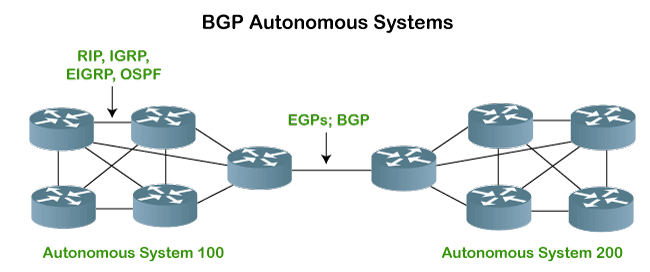
An autonomous system is a collection of networks that comes under the single common administrative domain. Or we can say that it is a collection of routers under the single administrative domain. For example, an organization can contain multiple routers having different locations, but the single autonomous number system will recognize them. Within the same autonomous system or same organization, we generally use IGP (Interior Gateway Protocol) protocols like RIP, IGRP, EIGRP, OSPF. Suppose we want to communicate between two autonomous systems. In that case, we use EGP (Exterior Gateway Protocols). The protocol that is running on the internet or used to communicate between two different autonomous number systems is known as BGP (Border Gateway Protocol). The BGP is the only protocol that is running on the internet backbone or used to exchange the routes between two different autonomous number systems. Internet service providers use the BGP protocol to control all the routing information.
BGP Features
The following are the features of a BGP protocol:
- Open standard
It is a standard protocol which can run on any window device.
- Exterior Gateway Protocol
It is an exterior gateway protocol that is used to exchange the routing information between two or more autonomous system numbers.
- InterAS-domain routing
It is specially designed for inter-domain routing, where interAS-domain routing means exchanging the routing information between two or more autonomous number system.
- Supports internet
It is the only protocol that operates on the internet backbone.
- Classless
It is a classless protocol.
- Incremental and trigger updates
Like IGP, BGP also supports incremental and trigger updates.
- Path vector protocol
The BGP is a path vector protocol. Here, path vector is a method of sending the routes along with routing information.
- Configure neighborhood relationship
It sends updates to configure the neighborhood relationship manually. Suppose there are two routers R1 and R2. Then, R1 has to send the configure command saying that you are my neighbor. On the other side, R2 also has to send the configure command to R1, saying that R1 is a neighbor of R1. If both the configure commands match, then the neighborhood relationship will get developed between these two routers.
- Application layer protocol
It is an application layer protocol and uses TCP protocol for reliability.
- Metric
It has lots of attributes like weight attribute, origin, etc. BGP supports a very rich number of attributes that can affect the path manipulation process.
- Administrative distance
If the information is coming from the external autonomous system, then it uses 20 administrative distance. If the information is coming from the same autonomous system, then it uses 200 administrative distance.
BGP's Loop prevention mechanism
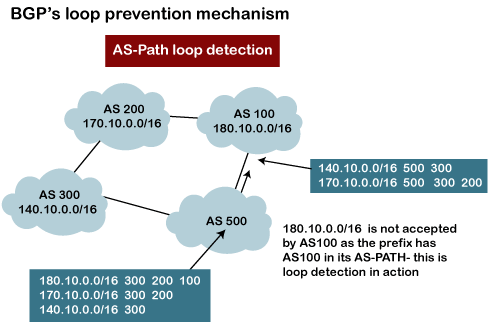
There is a possibility that when you are connecting to the internet, then you may be advertising route 10.0.0.0 to some autonomous system, then it is advertised to some other autonomous system. Then there is a possibility that the same route is coming back again. This creates a loop. But, in BGP, there is a rule that when the router sees its own AS number for example, as shown in the above figure, the network 180.10.0.0/16 is originating from the AS 100, and when it sends to the AS 200, it is going to carry its path information, i.e., 180.10.0.0/16 and AS 100. When AS 200 sends to the AS 300, AS 200 will send its path information 180.10.0.0/16 and AS path is 100 and then 200, which means that the route originates from AS 100, then reaches 200 and finally reaches to 300. When AS 300 sends to the AS 500, it will send the network information 180.10.0.0/16, and AS path is 100, 200, and then 300. If AS 500 sends to the AS 100, and AS 100 sees its own autonomous number inside the update, it will not accept it. In this way, BGP prevents the loop creation.
Types of Autonomous systems
The following are the types of autonomous systems:
- Stub autonomous system
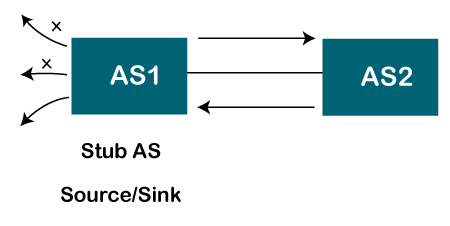
It is a system that contains only one connection from one autonomous system to another autonomous system. The data traffic cannot be passed through the stub autonomous system. The Stub AS can be either a source or a sink. If we have one autonomous system, i.e., AS1, then it will have a single connection to another autonomous system, AS2. The AS1 can act either as a source or a sink. If it acts as a source, then the data moves from AS1 to AS2. If AS1 acts as a sink, means that the data gets consumed in AS1 which is coming from AS2, but the data will not move forward from AS1.
- Multihomed autonomous system
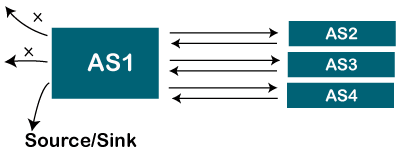
It is an autonomous system that can have more than one connection to another autonomous system, but it can still be either a source or a sink for data traffic. There is no transient data traffic flow, which means that the data can be passed from one autonomous system.
- Transient Autonomous System
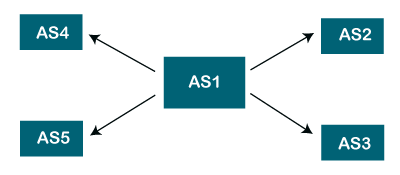
The transient autonomous system is a multihomed autonomous system, but it also provides transient traffic flow.
Path attributes
The BGP chooses the best route based on the attributes of the path.
As we know that path-vector routing is used in the border gateway routing protocol, which contains the routing table that shows the path information. The path attributes provide the path information. The attributes that show or store the path information are known as path attributes. This list of attributes helps the receiving router to make a better decision while applying any policy. Let's see the different types of attributes. The path attribute is broadly classified into two categories:

1. Well-known attribute: It is an attribute that should be recognized by every BGP router.
The well-known attribute is further classified into two categories:
- Well-known mandatory: When BGP is going to advertise any network, but it also advertises extra information, and that information with path attributes information. The information includes AS path information, origin information, next-hop information. Here, mandatory means that it has to be present in all the BGP routing updates.
- Well-known discretionary: It is recognized by all the BGP routers and passed on to other BGP routers, but it is not mandatory to be present in an update.
2. Optional attribute: It is an attribute that is not necessarily to be recognized by every BGP router. In short, we can say that it is not a mandatory attribute.
The optional attribute is further classified into two categories:
- Optional transitive: BGP may or may not recognize this attribute, but it is passed on to the other BGP neighbors. Here, transitive means that if the attribute is not recognized, then it is marked as a partial.
- Optional non-transitive: If the BGP cannot recognize the attribute, it ignores the update and does not advertise to another BGP router.
BGP Neighbors
BGP neighborship is similar to the OSPF neighborship, but there are few differences. BGP forms the neighboring relationship with the help of the TCP connection on port number 179 and then exchanges the BGP updates. They exchange the updates after forming the neighbor relationship. In BGP, the neighbor relationship is configured manually. BGP neighbors are also known as BGP peers or BGP speakers.
There are two types of neighbor relationship:
- IBGP (Internal BGP): If all the routers are neighbors of each other and belong to the same autonomous number system, the routers are referred to as an IBGP.
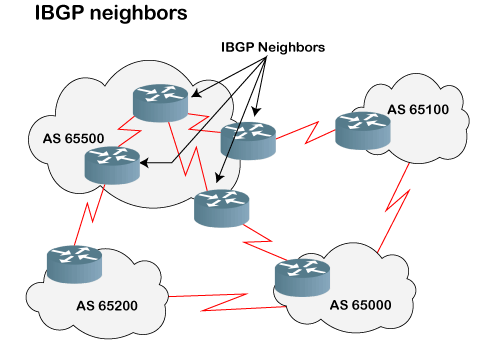
- EBGP (External BGP): If all the routers are neighbors of each other and they belong to the different autonomous number systems, then the routers are referred to as an EBGP.
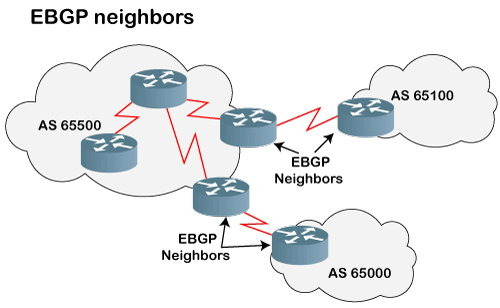
BGP Tables
There are three types of BGP tables:
- Neighbor table: It contains the neighbors who are configured by the administrator manually. The neighbor relationship has to be manually configured by using the neighbor command.
For the verification, the following commands are used:
- #show ip bgp summary
- # show ip bgp neighbors
The above commands are very useful to verify whether the neighbor relationship is up or not.
- BGP forwarding table: It contains all the routes advertised in BGP and can be verified using the following command:
- # show ip bgp
- IP routing table: The IP routing table contains the best path routes required to reach the destination. The following command shows the best routing path:
- #SH ip route
BGP Sessions
When we talk about the BGP, which means that the communication between the autonomous systems. Let's consider two autonomous systems having five nodes each.
BGP sessions are classified into two categories:
1. Internal BGP session
The internal BGP session is used to exchange information between the routers inside an autonomous system. In short, we can say that the routing information is exchanged between the routers of the same autonomous system.
2. External BGP session
The external BGP session is a session in which nodes or routers of different autonomous systems communicate with each other.
Types of packets
There are four different types of packets exist in BGP:
- Open: When the router wants to create a neighborhood relation with another router, it sends the Open packet.
- Update: The update packet can be used in either of the two cases:
- It can be used to withdraw the destination, which has been advertised previously.
- It can also be used to announce the route to the new destination.
- Keep Alive: The keep alive packet is exchanged regularly to tell other routers whether they are alive or not. For example, there are two routers, i.e., R1 and R2. The R1 sends the keep alive packet to R2 while R2 sends the keep alive packet to R1 so that R1 can get to know that R2 is alive, and R2 can get to know that R1 is alive.
- Notification: The notification packet is sent when the router detects the error condition or close the connection.
BGP Packet Format
Now we will see the format in which the packet travels. The following are the fields in a BGP packet format:
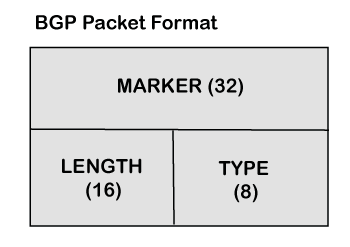
- Marker: It is a 32-bit field which is used for the authentication purpose.
- Length: It is a 16-bit field that defines the total length of the message, including the header.
- Type: It is an 8-bit field that defines the type of the packet.


